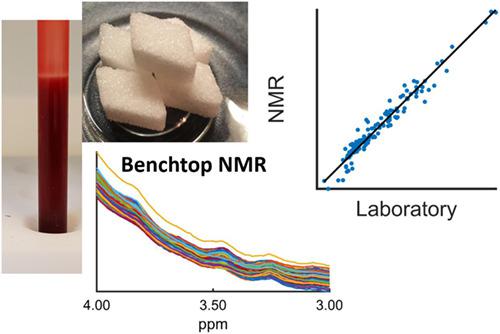当前位置:
X-MOL 学术
›
NMR Biomed.
›
论文详情
Our official English website, www.x-mol.net, welcomes your feedback! (Note: you will need to create a separate account there.)
Feasibility of precise and reliable glucose quantification in human whole blood samples by 1 tesla benchtop NMR.
NMR in Biomedicine ( IF 2.9 ) Pub Date : 2020-07-02 , DOI: 10.1002/nbm.4358 Michael Stolz 1 , Carolin Schlawne 2 , Jens Hoffmann 2 , Vanessa Hartmann 3, 4, 5 , Irene Marini 1 , Andreas Fritsche 3, 4, 5 , Andreas Peter 3, 4, 6 , Tamam Bakchoul 1 , Fritz Schick 3, 7
NMR in Biomedicine ( IF 2.9 ) Pub Date : 2020-07-02 , DOI: 10.1002/nbm.4358 Michael Stolz 1 , Carolin Schlawne 2 , Jens Hoffmann 2 , Vanessa Hartmann 3, 4, 5 , Irene Marini 1 , Andreas Fritsche 3, 4, 5 , Andreas Peter 3, 4, 6 , Tamam Bakchoul 1 , Fritz Schick 3, 7
Affiliation

|
The standard procedure for blood glucose measurements is enzymatic testing. This method is cheap, but requires small samples of open blood with direct contact to the test medium. In principle, NMR provides non‐contact analysis of body fluids, but high‐field spectrometers are expensive and cannot be easily utilized under clinical conditions. Low‐field NMR systems with permanent magnets are becoming increasingly smaller and more affordable. The studies presented here aim at exploring the capabilities of low‐field NMR for measuring glucose concentrations in whole blood. For this purpose, a modern 1 T benchtop NMR spectrometer was used. Challenges arise from broad spectral lines, the glucose peak locations close to the water signal, low SNR and the interference with signals from other blood components. Whole blood as a sample comprises even more boundary conditions: crucial for reliable results are avoiding the separation of plasma and cells by gravitation and reliable reference values. First, the accuracy of glucose levels measured by NMR was tested using aqueous glucose solutions and commercially available bovine plasma. Then, 117 blood samples from oral glucose tolerance testing were measured with minimal preparation by simple pulse‐acquire NMR experiments. The analysis itself is the key to achieve high precision, so several approaches were investigated: peak integration, orthogonal projection to latent structure analysis and support vector machine regression. Correlations between results from the NMR spectra and the routine laboratory automated analyzer revealed an RMSE of 7.90 mg/dL for the best model. 91.5% of the model output lies within the limits of the German Medical Association guidelines, which require the glucose measurement to be within 11% of the reference method. It is concluded that spectral quantification of glucose in whole blood samples by high‐quality NMR spectrometers operating at 1 T is feasible with sufficient accuracy.
中文翻译:

通过 1 特斯拉台式 NMR 对人全血样本进行精确可靠的葡萄糖定量的可行性。
血糖测量的标准程序是酶促检测。这种方法很便宜,但需要与测试介质直接接触的少量开放血液样本。原则上,核磁共振提供体液的非接触式分析,但高场光谱仪价格昂贵,在临床条件下不易使用。带有永磁体的低场 NMR 系统变得越来越小,价格也越来越便宜。这里介绍的研究旨在探索低场 NMR 测量全血中葡萄糖浓度的能力。为此,使用了现代 1 T 台式 NMR 光谱仪。挑战来自宽谱线、靠近水信号的葡萄糖峰值位置、低 SNR 以及对来自其他血液成分的信号的干扰。作为样本的全血包含更多边界条件:可靠结果的关键是避免通过重力和可靠参考值分离血浆和细胞。首先,使用葡萄糖水溶液和市售牛血浆来测试通过 NMR 测量的葡萄糖水平的准确性。然后,通过简单的脉冲获取 NMR 实验,以最少的准备量测量了来自口服葡萄糖耐量测试的 117 份血液样本。分析本身是实现高精度的关键,因此研究了几种方法:峰值积分、潜在结构分析的正交投影和支持向量机回归。NMR 光谱结果与常规实验室自动化分析仪结果之间的相关性表明,最佳模型的 RMSE 为 7.90 mg/dL。91. 模型输出的 5% 在德国医学协会指南的限制范围内,该指南要求葡萄糖测量值在参考方法的 11% 以内。结论是,通过在 1 T 下运行的高质量 NMR 光谱仪对全血样品中的葡萄糖进行光谱定量是可行的,并且具有足够的准确度。
更新日期:2020-08-04
中文翻译:

通过 1 特斯拉台式 NMR 对人全血样本进行精确可靠的葡萄糖定量的可行性。
血糖测量的标准程序是酶促检测。这种方法很便宜,但需要与测试介质直接接触的少量开放血液样本。原则上,核磁共振提供体液的非接触式分析,但高场光谱仪价格昂贵,在临床条件下不易使用。带有永磁体的低场 NMR 系统变得越来越小,价格也越来越便宜。这里介绍的研究旨在探索低场 NMR 测量全血中葡萄糖浓度的能力。为此,使用了现代 1 T 台式 NMR 光谱仪。挑战来自宽谱线、靠近水信号的葡萄糖峰值位置、低 SNR 以及对来自其他血液成分的信号的干扰。作为样本的全血包含更多边界条件:可靠结果的关键是避免通过重力和可靠参考值分离血浆和细胞。首先,使用葡萄糖水溶液和市售牛血浆来测试通过 NMR 测量的葡萄糖水平的准确性。然后,通过简单的脉冲获取 NMR 实验,以最少的准备量测量了来自口服葡萄糖耐量测试的 117 份血液样本。分析本身是实现高精度的关键,因此研究了几种方法:峰值积分、潜在结构分析的正交投影和支持向量机回归。NMR 光谱结果与常规实验室自动化分析仪结果之间的相关性表明,最佳模型的 RMSE 为 7.90 mg/dL。91. 模型输出的 5% 在德国医学协会指南的限制范围内,该指南要求葡萄糖测量值在参考方法的 11% 以内。结论是,通过在 1 T 下运行的高质量 NMR 光谱仪对全血样品中的葡萄糖进行光谱定量是可行的,并且具有足够的准确度。


























 京公网安备 11010802027423号
京公网安备 11010802027423号